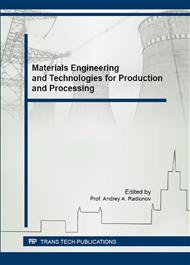p.173
p.178
p.183
p.189
p.195
p.203
p.208
p.213
p.217
On the Theory of Tetragonality of Martensite Crystals Surrounded with Elastic Matrix
Abstract:
The paper is dedicated to the study of thermodynamic stability of tetragonal and cubic states of dilute Fe–C interstitial solid solutions. The combination of the thermodynamic theory and atomistic simulations results was used. This approach allowed us to analyze a widespread theory of carbon ordering in martensite crystal lattice enclosed in an elastic matrix developed by A.G. Khachaturyan. The key parameter of the theory is λ0, the strain interaction parameter. The value of λ0 calculated by A.G. Khachaturyan for a free martensite crystal (2.73 eV/atom ) yields the critical concentration of carbon ccrit=0,55 wt. % for room temperature. In fact, according to the experimental works this concentrations is close to 0.25 wt. %. A.G. Khachaturyan offered an improved theory of carbon ordering based on the assumption that decreasing the sizes of crystals along z axis will cause elastic resistance from surrounding crystals. The stresses arising when the martensite crystal is enclosed in an elastic matrix causes the appearance of a “tail” of order parameter at concentrations below the ccr for free crystal, which explained the discrepancy between Khachaturian’s theory and the experimental data. However our analysis shows the absence of this “tail” that means incorrect calculation of λ0 parameter. Over the last ten years the calculations of the strain interaction parameter λ0 have been made. The values of the parameter λ0 range from 5 to 10 eV/atom, in contrast to 2.73 eV/atom as defined by A.G. Khachaturyan. This fact has a great effect on the estimates of the critical carbon concentration at room temperature. This concentration becomes close to 0.2 wt. %, the value previously indicated by G.V. Kurdjumov. The reasons of abnormal tetragonality observed in the 0.2–0.6 wt. %C range are also considered.
Info:
Periodical:
Pages:
195-200
Citation:
Online since:
February 2016
Authors:
Keywords:
Price:
Сopyright:
© 2016 Trans Tech Publications Ltd. All Rights Reserved
Share:
Citation:


